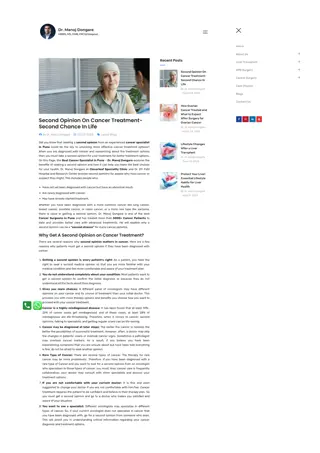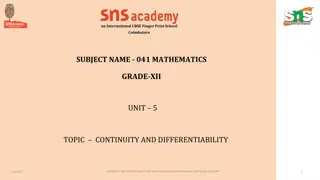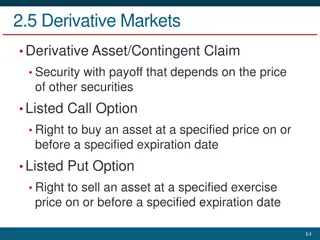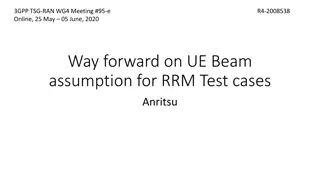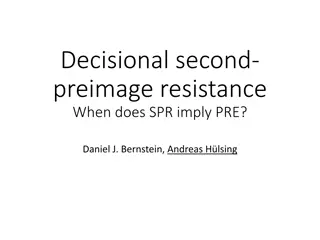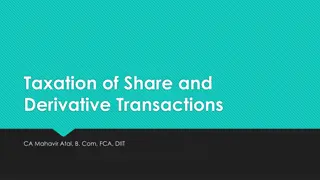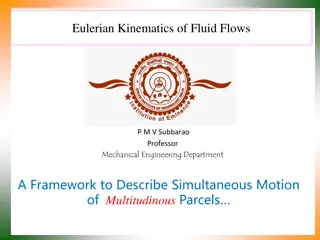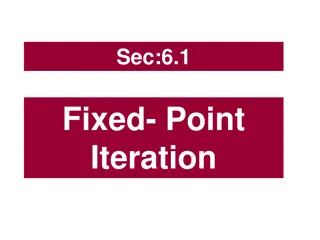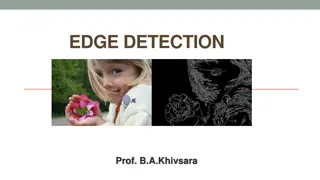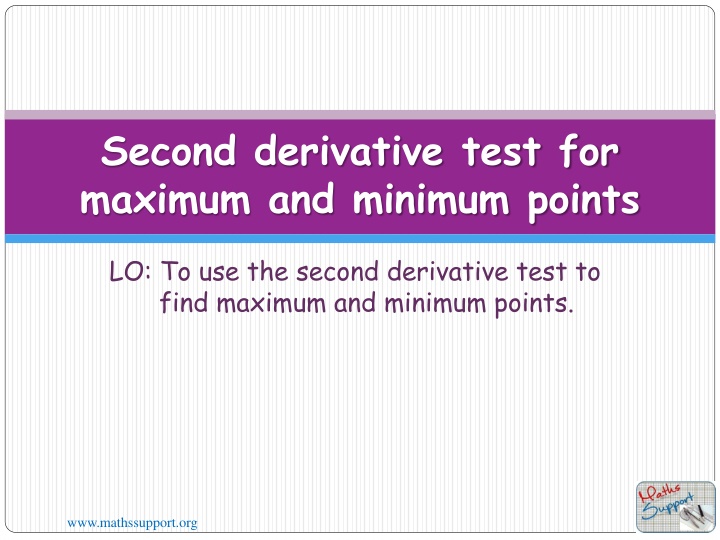
Second Derivative Test for Maximum and Minimum Points
Learn how to apply the second derivative test to identify maximum and minimum points of a curve. Discover the concepts of concavity, inflexion points, and concave shapes, along with practical examples and interpretations. Enhance your understanding of calculus and optimize your problem-solving skills.
Download Presentation

Please find below an Image/Link to download the presentation.
The content on the website is provided AS IS for your information and personal use only. It may not be sold, licensed, or shared on other websites without obtaining consent from the author. If you encounter any issues during the download, it is possible that the publisher has removed the file from their server.
You are allowed to download the files provided on this website for personal or commercial use, subject to the condition that they are used lawfully. All files are the property of their respective owners.
The content on the website is provided AS IS for your information and personal use only. It may not be sold, licensed, or shared on other websites without obtaining consent from the author.
E N D
Presentation Transcript
Second derivative test for maximum and minimum points LO: To use the second derivative test to find maximum and minimum points. www.mathssupport.org
Shape type When a curve, or part of a curve, has shape We say that the shape is concave down. When a curve, or part of a curve, has shape We say that the shape is concave up. www.mathssupport.org
Test for shape This is another test to determine the nature of maximum and minimum points. Lets look at the gradient of the curve at some points. Consider the concave up curve: Notice that as x increases for all the points on the curve the slope is increasing. f (x)is increasing Therefore its derivative is positive and f (c) > 0 m5 = 4 m1 = -4 m2 = -2 and f (c) = 0 m4 = 2 c a b d e m3 = 0 x increases f (x) > 0 If f (c) = 0 and f (x) >0 for all xin the interval (a, e) thenf (x) has a local minimum at x = c, and is concave up on the interval(a, e). www.mathssupport.org
Test for shape This is another test to determine the nature of maximum and minimum points. Lets look at the gradient of the curve at some points. Consider the concave down curve: Notice that as x increases for all the points on the curve the slope is decreasing. f (x)is decreasing, Therefore its derivative is negative and f (c) < 0 m3 = 0 and f (c) = 0 m2 = 2 m4 = -2 m5 = -4 m1 = 4 c a b d e f (x) < 0 x increases If f (c) = 0 and f (x) < 0 for all x in the interval (a, e) thenf (x) has a local maximum at x = c, and is concave down on the interval(a, e). www.mathssupport.org
Points of inflexion The points on a curve where the concavity changes are called inflexion points point of inflexion point of inflexion The graph in blue is concave up. The graph in red is concave down. The graph in blue is concave up. The point where the concavity changes is the point of inflexion A point on the graph of f is an inflexion point if f (x) =0 and f (x) changes sign. The graph in red is concave down. The point where the concavity changes is the point of inflexion www.mathssupport.org
Concavity Use the second derivative to find the intervals where the function f(x) = 2x3 3x2 12x is concave up and concave down. Find the inflexion points. Find the second derivative of f f (x) = 6x2 6x 12 f (x) =12x 6 0 = 12x 6 x = 1 2 - Find where f (x)= 0 + Make a sign diagram for f 1 2 Evaluate f (x) to determine the f (0) = 6 f (0) =6 f (0) = 12(0)2 6 f (1) = 12(1)2 6 f is concave down on ,1 signs 2sincef (x) < 0 1 2, sincef (x) > 0 f is concave up on www.mathssupport.org
Concavity Use the second derivative to find the intervals where the function f(x) = 2x3 3x2 12x is concave up and concave down. Find the inflexion points. f is concave down on ,1 2sincef (x) < 0 2, sincef (x) > 0 1 f is concave up on Sincef (x) changes the sign at x = 1 an inflexion point there 2there is 3 3 2 12 1 2 = 2 1 2 1 2 1 2 Evaluate f at x = 1 y-coordinate of the inflexion point f 2to find the = 13 2 1 2, 13 So, the inflexion point is 2 www.mathssupport.org
Concavity Use the second derivative to find the intervals where the function f(x) = ?2 4 Find the inflexion points. f (x) = Find the second derivative of f ?2 1, is concave up and concave down. 6? ?2 12 = 6(3?2+ 1) ?2 13 26 (6?) 2 ?2 1 (2?) ?2 14 ?2 1 f (x) = Even though f (x) changes sign at x = 1 there are not inflexion points. This is because f(x) is undefined at x = 1 Find where f (x)= 0 6(3?2+ 1) ?2 13 6(3x2 + 1) = 0 f (x)is undefined when (x2 1)3 = 0 x2 1 = 0 = 0 x2 = 1 x = 1 x2 = 1 In this case the concavity is changing on either side of a vertical asymptote 3 No real solutions + - - Make a sign diagram for f f is concave down on , 1 and (1, ) since f (x) < 0 and f is concave up on 1,1 since f (x) > 0 1 -1 www.mathssupport.org
Concavity Use the second derivative to find the intervals where the function f(x) = x3, is concave up and concave down. Find the inflexion points. f (x) = 3x2 Find the second derivative of f f (x) =6x 6x = 0 x = 0 Find where f (x)= 0 + - Make a sign diagram for f 0 f is concave down on ,0 since f (x) < 0 f is concave up on 0, since f (x) > 0 Sincef (x) changes the sign atx = 0 there is an inflexion point there f(0) = 03 = 0 So, the inflexion point is (0, 0) www.mathssupport.org
Given that the graph shown is a graph of f , sketch the graphs of f and f . Since f equals zero when x= -1 and changes from positive to negative, the graph of f has a relative maximum when x= -1 y Since f (x) equals zero when x= 7 and changes from negative to positive the graph of f has a relative minimum when x= 7 . Since f (x) has a relative minimum when x= 3 the graph of f (x) equals zero when x= 3 10 9 8 f (x) 7 6 5 4 3 2 1 -10 1 2 3 4 5 6 7 9 10 -9 -8 -7 -6 -5 -4 -3 -2 8 -1 0 -1 x -2 Sincef (x) is concave down for x < 3 f (x) is negative for x < 3 -3 -4 f (x) -5 -6 Sincef (x) is concave up for x > 3f (x) is positive for x > 3 f (x) -7 -8 -9 www.mathssupport.org
Given that the graph shown is a graph of f, sketch the graphs of f and f The graph changes from decreasing to increasing and has a relative minimum at x= 3 y 10 This means that f (x) equals zero at x= 3 And changes from negative to positive. 9 f (x) 8 7 6 5 4 f (x) 3 The graph of f is always concave up. This means that f (x) is always positive. Since f (x) is the derivative of f (x), a linear function, f (x) must be a positive constant. 2 1 -10 1 2 3 4 5 6 7 9 10 -9 -8 -7 -6 -5 -4 -3 -2 8 -1 0 -1 x -2 -3 -4 -5 -6 f (x) -7 -8 -9 www.mathssupport.org
Thank you for using resources from A close up of a cage Description automatically generated For more resources visit our website https://www.mathssupport.org If you have a special request, drop us an email info@mathssupport.org www.mathssupport.org

